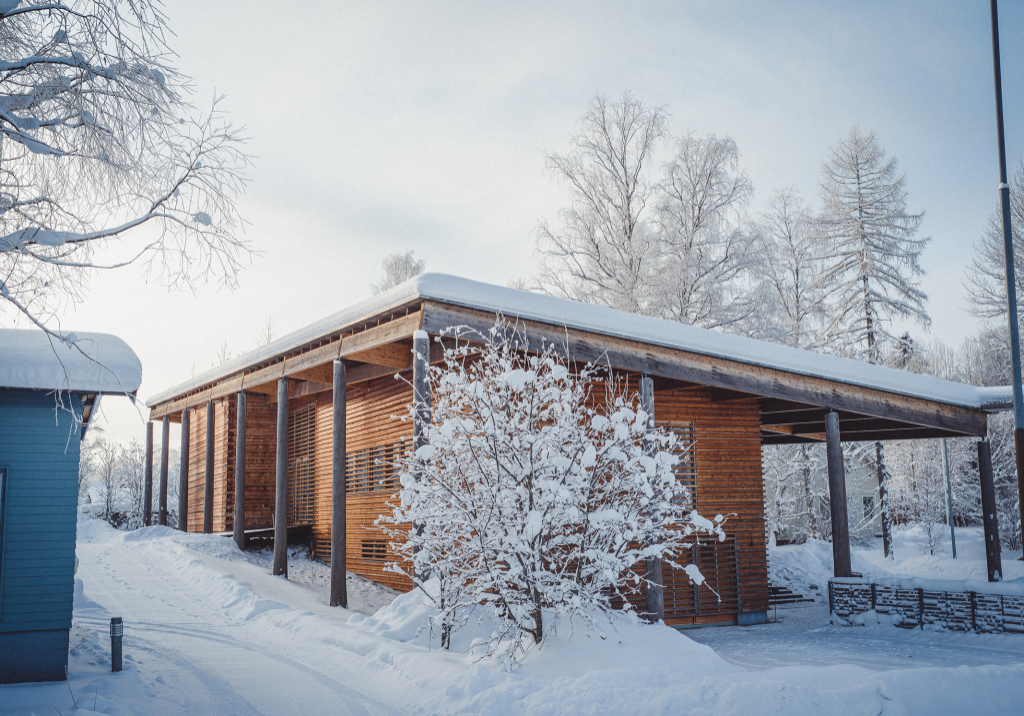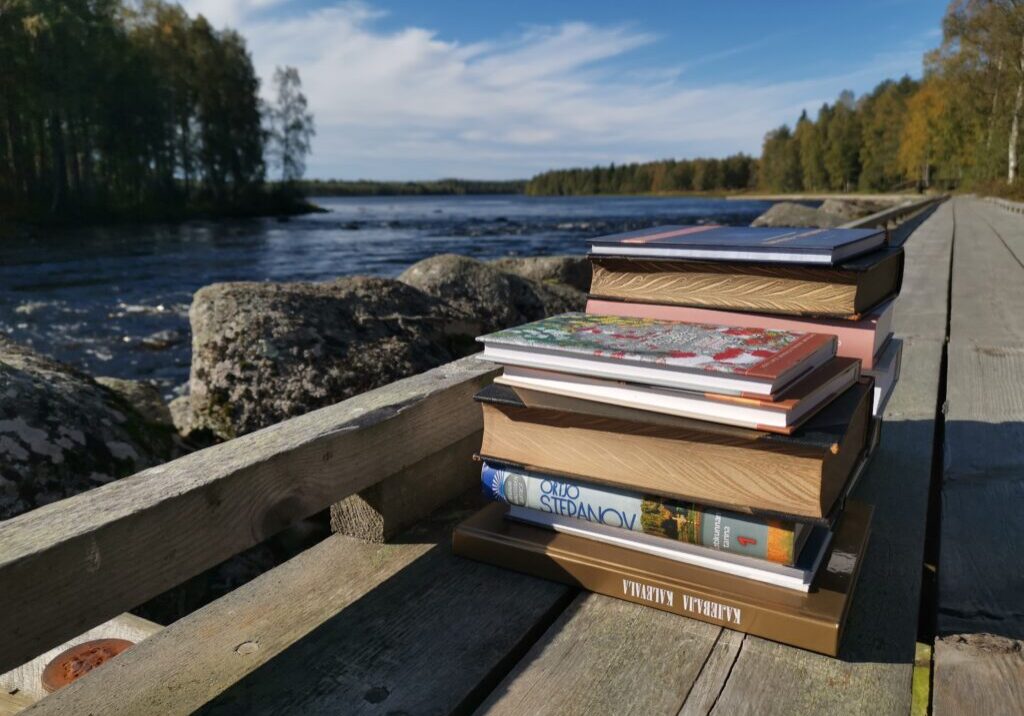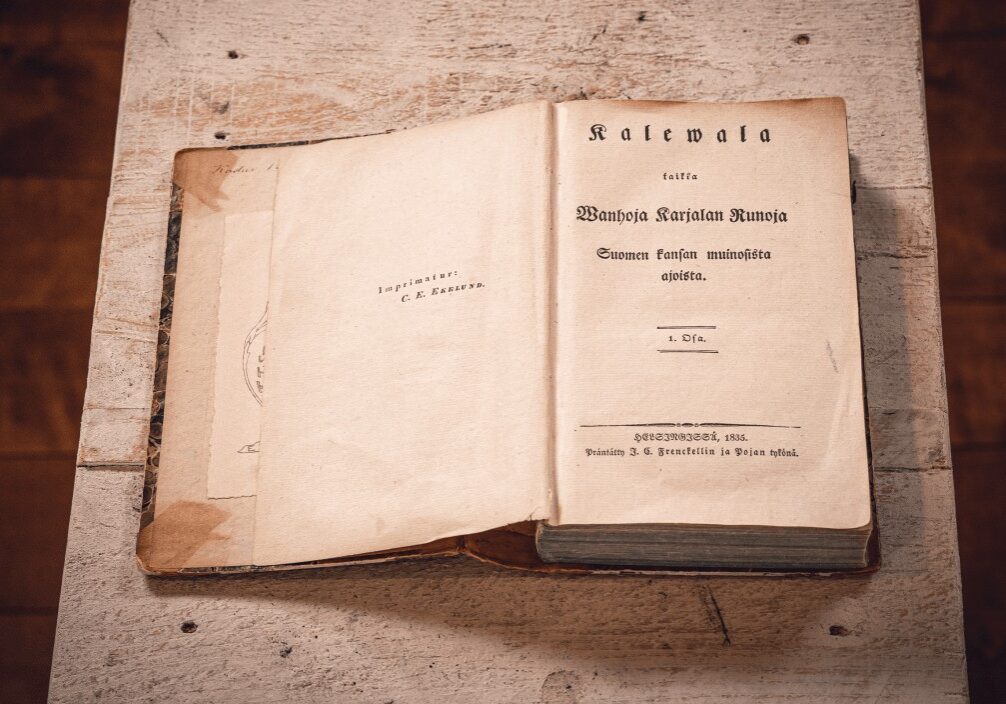Lönnrot's journeys in Kainuu
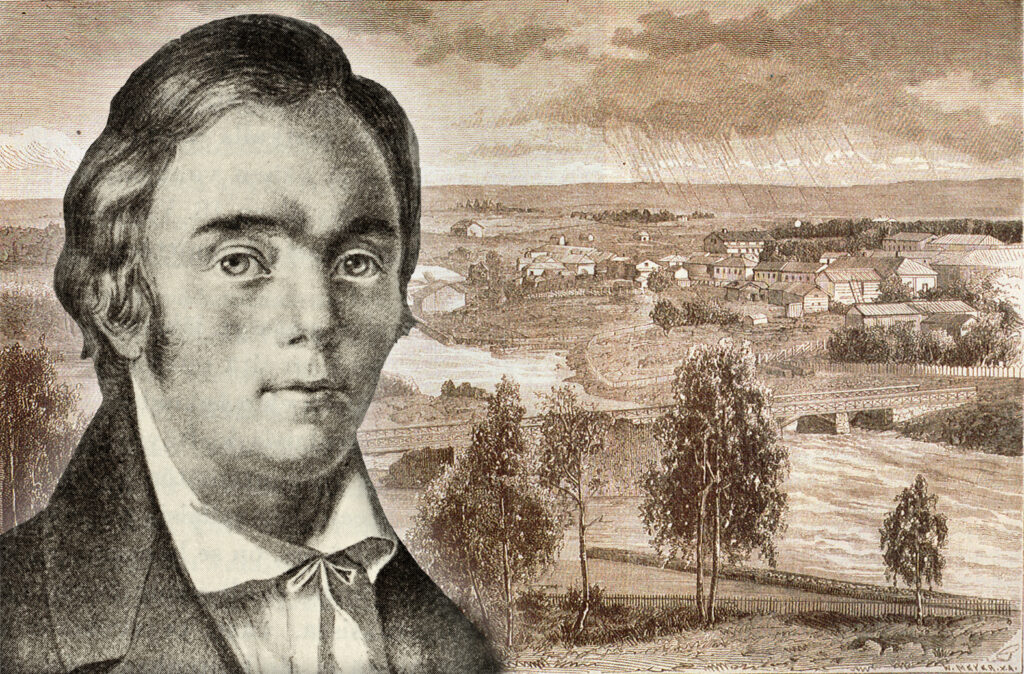
Lönnrot's journeys in Kainuu are quite well documented. For every single route of his business trips he made travel invoices to the Medical Board, and he wrote quite detailed travelogues about his poetry collection trips.
He also collected poetry in Kainuu though not systematically, but whenever there was the chance. Kainuu has suffered from the so-called “problem of the passer-by”: because Lönnrot wanted so bad to reach the glorious singing lands of the Karelia of the White Sea, he wasted no time in his hosting province, even though he would have gotten the best that Finland had to offer.
The first journey 1828
The purpose of Lönnrot's poetry collection journeys was to collect sung folk poetry, or runosongs, which - especially epic poetry - was believed at that time to contain information about ancient history. This would have helped to develop a common Finnish identity. Lönnrot was committed to this tast already during the years as a student at the University of Turku.
Elias Lönnrot made his 1st trip to collect poetry from spring to autumn 1828, fresh from the university. His plans for this first trip included a visit to the Karelia of the White Sea, but this ambition was frustrated. He did not did not get any farther than Nurmes. So, on this trip he didn't make it not even to Kainuu.
The most productive journey was the one to Kesälahti, during which he met Juhana Kainulainen, who alone sang him over 2000 verses.
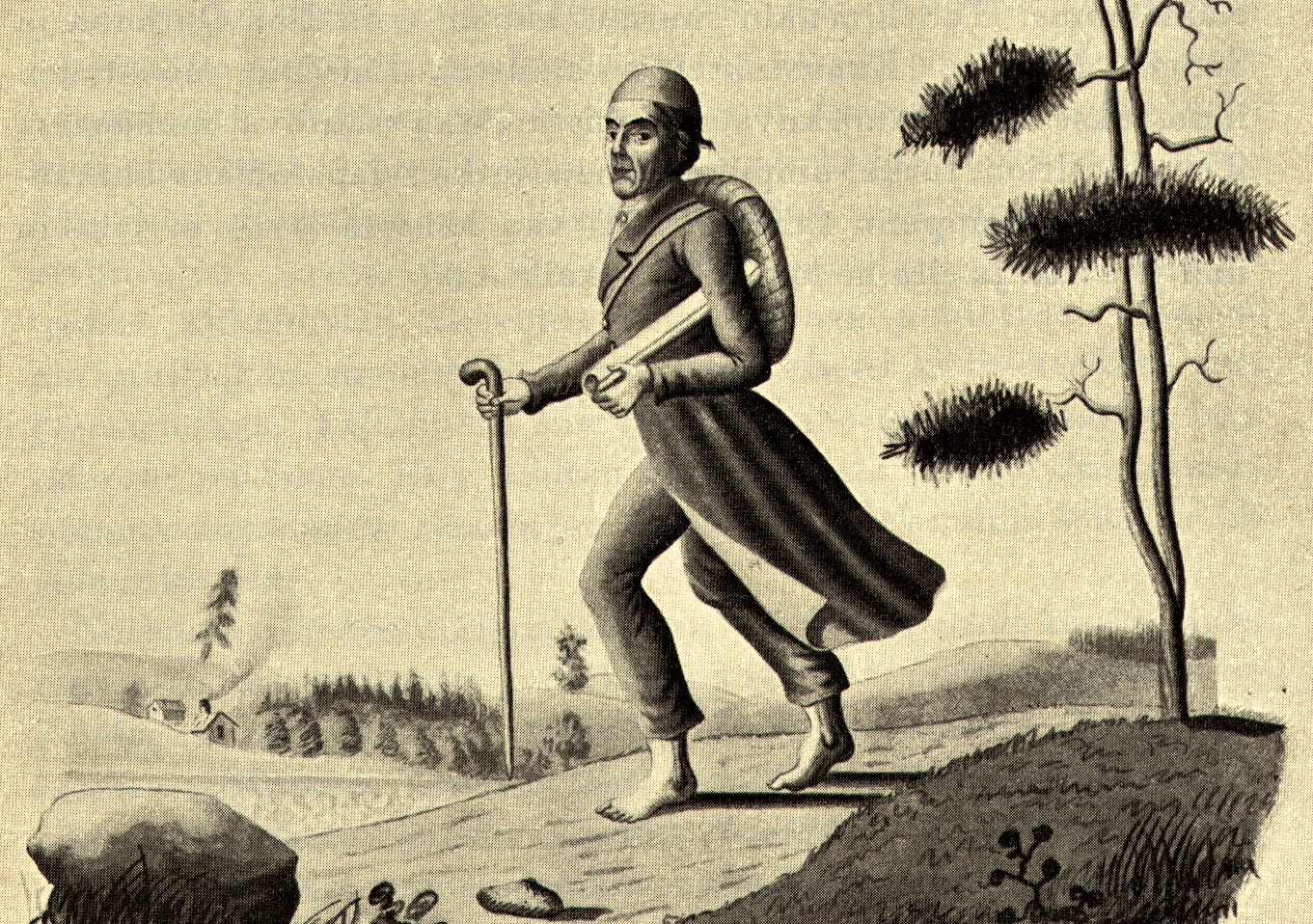
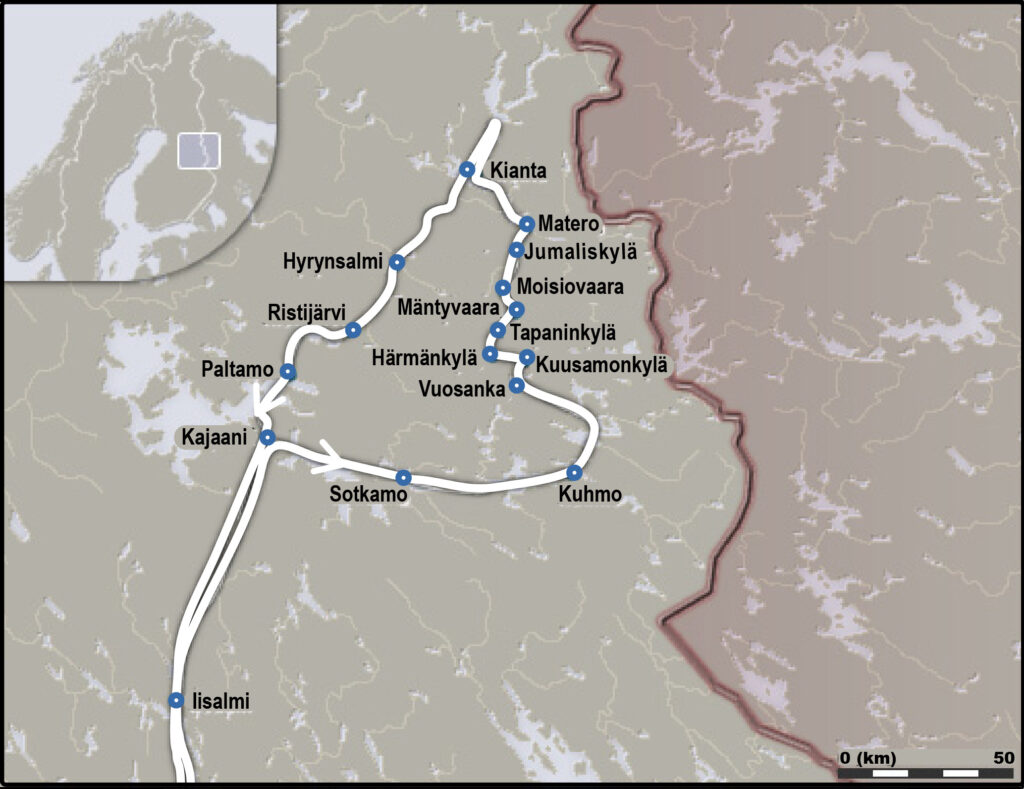
The second journey 1831
On his 2nd journey (Helsinki 28.5. - Helsinki 22.8.1831) Lönnrot wanted to reach the Karelia of the White Sea, where the ancient runosongs were still alive.
The journey, sponsored by the Finnish Literature Society, had to be inturrupted due to an epidemy that forced him to returned to Helsinki an face the situation as a doctor.
Here is the itinerary:
Helsinki - Rautalampi - Pielavesi - Iisalmi - Kajaani - Sotkamo - Kuhmo - Kianta - Hyrynsalmi - Ristijärvi - Paltamo - Kajaani - Iisalmi - Helsinki.
He travelled through seven Kainuu districts: Kajaani, Sotkamo, Kuhmo, Hyrynsalmi, Suomussalmi, Ristijärvi and Paltamo.
The third journey 1832
Lönnrot's 3rd journey started in Vesilahti, Laukko (13.7.1832), and finished in Helsinki (17.9.1832).
Here is the itinerary: Vesilahti - Tampere - Jyväskylä - Kuopio - Kaavi - Nilsiä - Nurmes - Kuhmon Saunavaara - Repola - Akonlahti - Kuhmo - Kajaani - Kuopio - Porvoo - Helsinki.
After a fast-paced but slow-moving start, Lönnrot finally reached the Karelia of the White Sea for the first time. Unfortunately he didn't have time to go further than Akonlahti. However, he realized that the Karelia of the White Sea was rich in folk songs, and that’s where his next trips would have headed.
He travelled through three Kainuu districts: Kuhmo, Sotkamo and Kajaani.
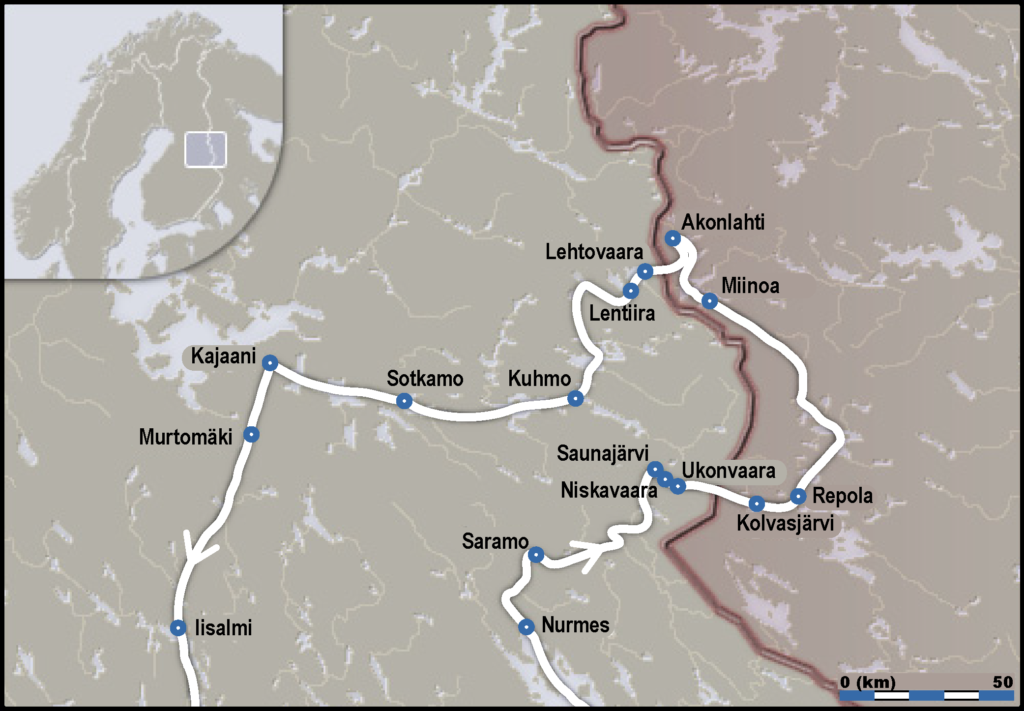
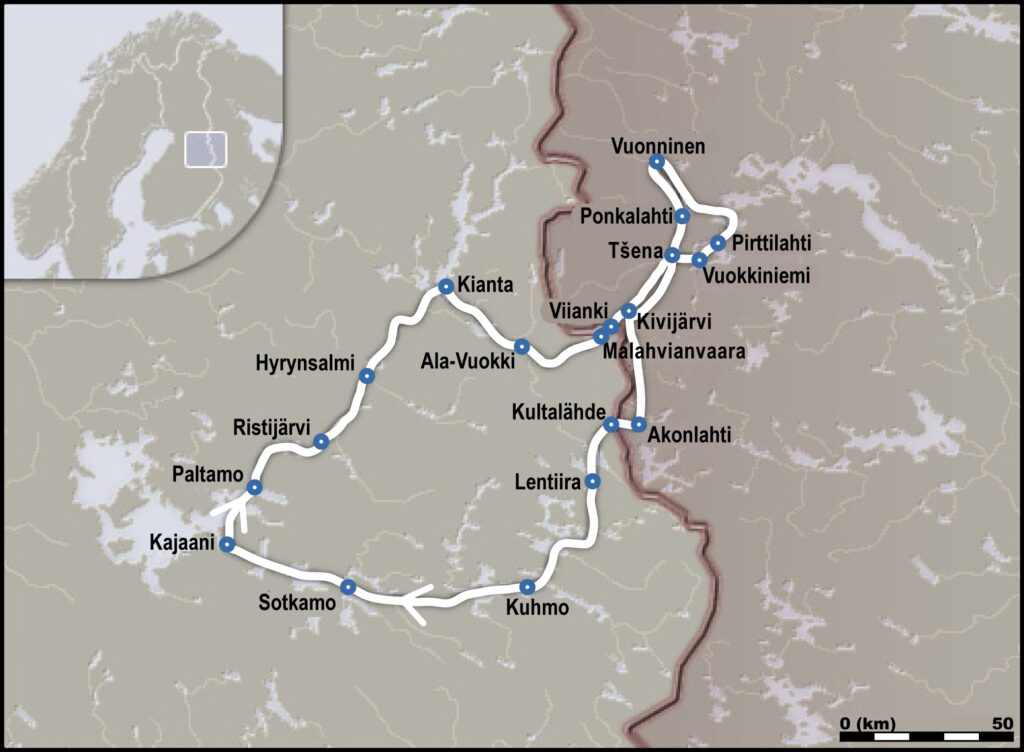
The fourth journey 1833
In January 1833 Elias Lönnrot moved to Kajaani. Kainuu became his home for 2 years and from tehre he set out for his poetry collection journeys.
His 4th journey (9.-28.9.1833) was the most important for the birth of the Kalevala since he got the idea of writing an epic from the gathered folk material. He described the itinerary in detail (Kajaani - Paltamo - Ristijärvi - Hyrynsalmi - Kianta - Kivijärvi - Tšena - Ponkalahti - Vuonninen - Pirttilahti - Vuokkiniemi - Tšena - Kivijärvi - Akonlahti - Kuhmo - Sotkamo - Kajaani) since it was also a business trip, during which he made a 10-days deviation to the Karelia of the White Sea.
Later in the same year, in November, Lönnrot send the description of his journey to J. L. Runeberg, who published it the next year in the newspaper Helsingfors Morgonblad.
The fifth journey 1834
The 5th journey (13.4. - 30.4.1834) was pretty important as for the contents of the Kalevala since Lönnrot met Arhippa Perttunen, the greatest White Karelian runosinger of that time and whose influence on the contents of the epic was extraordinary.
Here is the itinerary: Kajaani - Paltamo - Ristijärvi - Hyrynsalmi - Kianta - Lonkka - Vuonninen - Jyvöälahti - Uhtua - Jyvöälahti - Pirttilahti - Vuokkiniemi - Tšena - Kivijärvi - Latvajärvi - Kianta - Hyrynsalmi - Ristijärvi - Paltamo - Kajaani.
Immediately after returning from this journey, Lönnrot wrote to the Finnish Literature Society to suspend the printing of the manuscript of that Kalevala, which he had given to the Society.
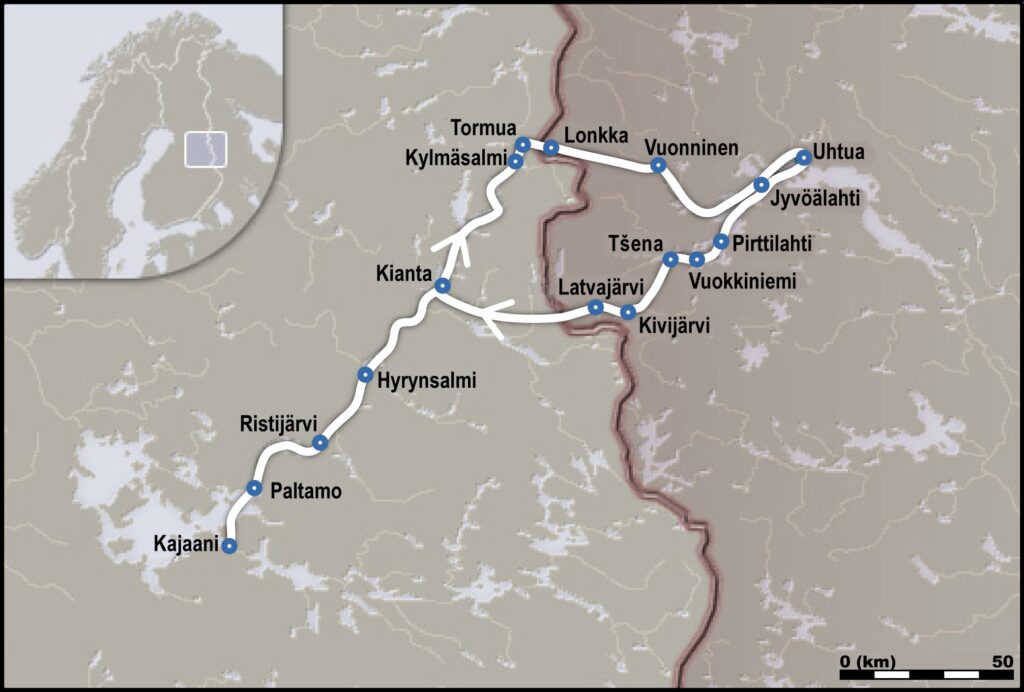
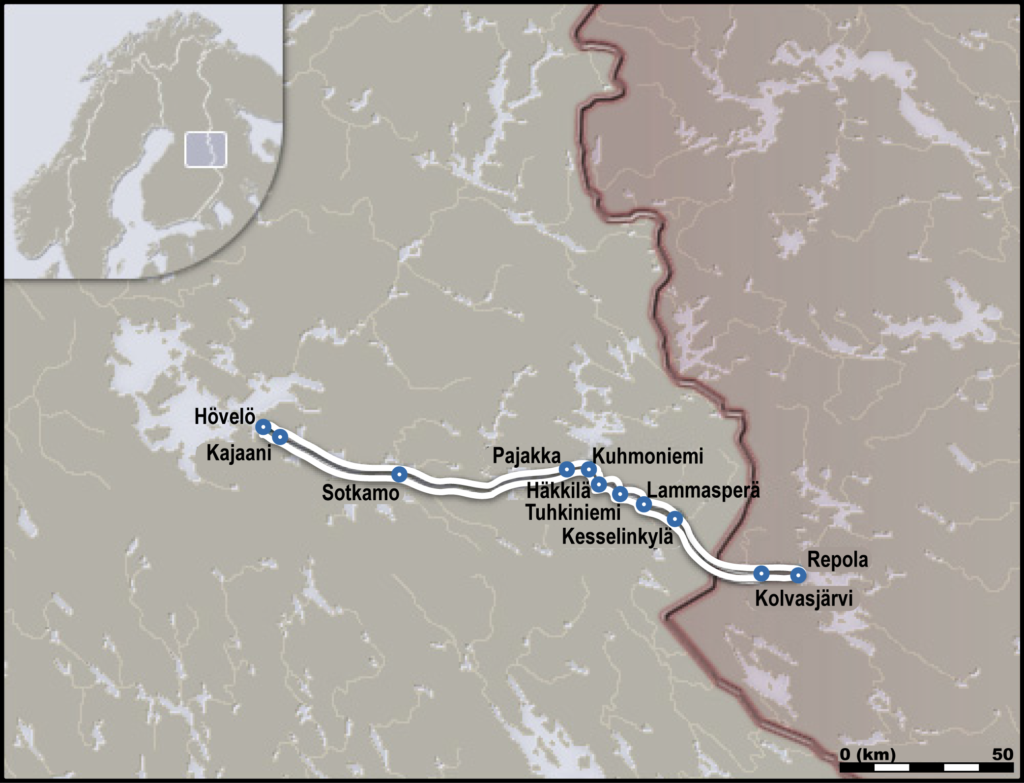
The journey in the autumn 1834
During October-November 1834 Lönnrot went to Kuhmo on a business trip but made a deviation to Repola looking for eventual additions to the Kalevala.
The manuscript was almost ready. The last adjustments happended in part during this journey: the third manuscript of the epic is dated 11th of November 1834, Kuhmo. This version included the last 11 poems of the Kalevala and 4018 verses, so over a third of the entire content of the Kalevala.
On his return trip from Repola to Kuhmo he passed from Sotkamo and then continued to Kajaani.
The sixth journey 1835
Even once the Kalevala was ready, Lönnrot continued collecting folk material, for he had in mind the "completion" of the Kalevala. In the spring 1835, he set out again, combining his duties to the poetry collection in the Karelia of the White Sea to study the runosongs of the southern and eastern areas. At the same time, he took the vaccines to Repola, since the previous year he noticed they weren't enough.
The business trip that started in Kajaani on the 4th of April and brough Lönnrot to the municipalities of eastern Kainuu didn't go as expected. Lönnrot got stuck in Kuhmo's rectory for some days and in his letter he tells C. N. Keckman why. The trip ended in Kajaani in early May.
As a result of the 6th trip, Lönnrot acquired 103 songs and about 4 500 verses.
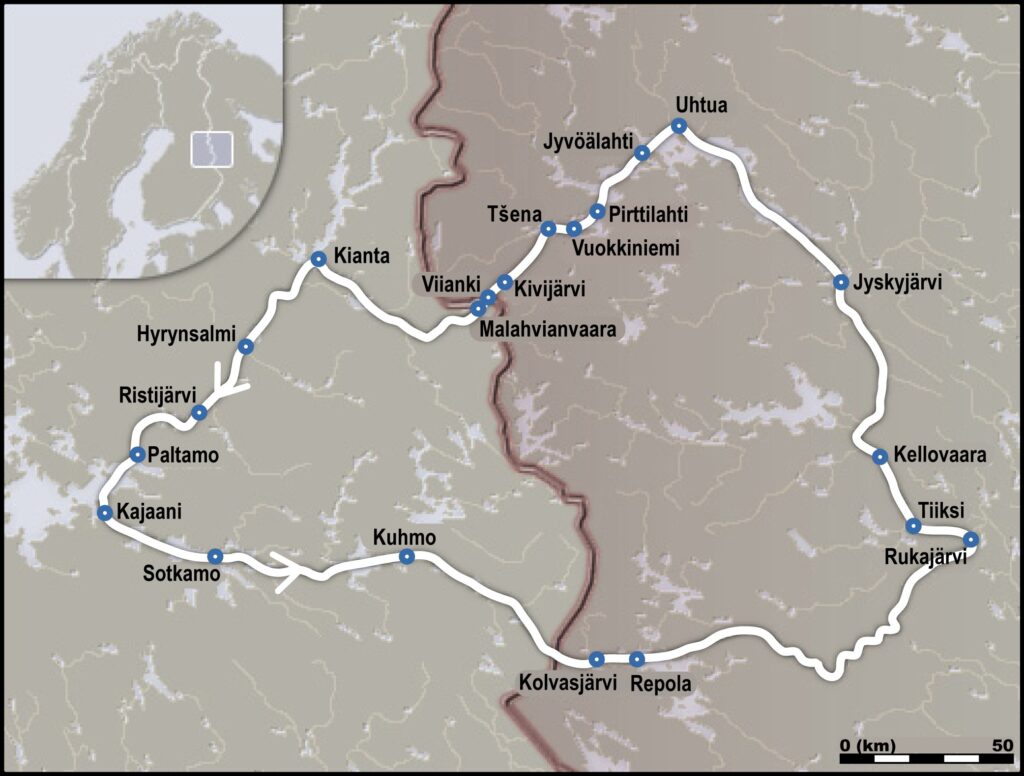

The journey to Lapukka 1835
Lönnrot stopped in Lapukka out of curiosity. He wanted to see the place where the Great Iivana, Arhippa Perttunen's father, had sung. Arhippa told him that his father was an extraordinary runosinger. When he met Arhippa Perttunen in Latvajärvi, he was given an eloquent account of traditional runosinging in Lapukka:
You should have been there that time we rested by the campfire after seine fishing on the shores of Lapukka. We had a helper with us, a man from Lapukka - a fine singer - but by no means anything to match my late father. They would sing night after night hand in hand by the fire, and it was never the same poem twice. I was a little boy then and I listened to them, and little by little I picked up the best songs.
Here is the itinerary: Kajaani - Paltamo - Ristijärvi - Hyrynsalmi - Kianta - Puolanka - Ristijärvi - Paltamo - Kajaani.
The seventh journey
In 1836, Lönnrot received a grant from the Finnish Literature Society to map the distribution of the runosongs both in the north and the south. He received one year's leave of absence, which was extended to 14 months, in order to undertake an extensive field trip. The research plan stipulated that "first he was to visit the Finns living close to the national border from Kajaani to the north, and from there the trip was to proceed to the southeast, partly on the Russian, partly on the Finnish side."
In practice, the field trip was completed in two stages, as Lönnrot returned to Kajaani for a while after the trip north.

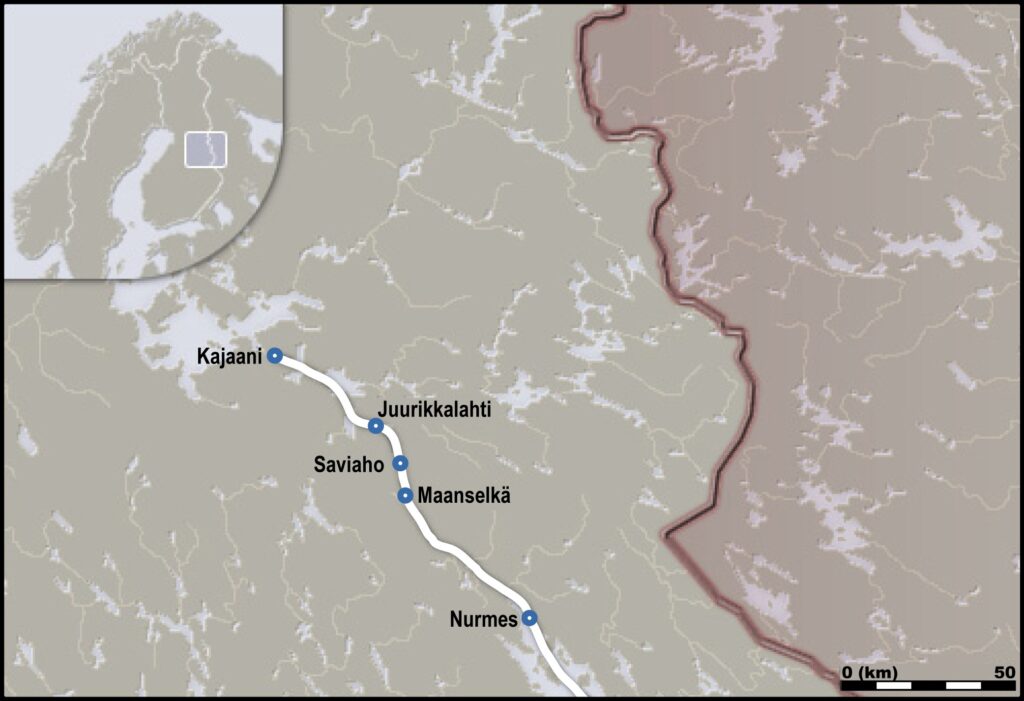
The eighth journey 1838
We don't have much information about the 8th journey.
Here is the most likely itinerary: Kajaani (Polvila) - Sotkamo - Nurmes - Ilomantsi - Pielisjärvi - Kajaani
The most significant encounter was Mateli Kuivalatar in Ilomantsi.
The ninth journey 1839
Previous researchers have been inconsistent in their records of Lönnrot's 9th field trip. Two separate trips have been recorded as a single journey, probably in this case because the first of these was "doubtless customary work-related travel in part, which we did not count as a poetry-collecting trip" (A.R. Niemi).
The fourth and sixth field trips were also normal work-related travel in part. In addition, Kaukonen points out, this work-related trip yielded 23 songs (350 lines) in Akonlahti alone, whereas Lönnrot's "official" poetry-collecting trip, that is, the one he undertook while on leave of absence, produced only 80 poems (800 lines).
The first part of the journey started in Kajaani 7.9.1839 and finished there about 10.10.1839. Here is the itinerary: Kajaani (Polvila) - Ristijärvi - Hyrynsalmi - Kianta - Akonlahti - Kuhmo - Sotkamo - Kajaani.
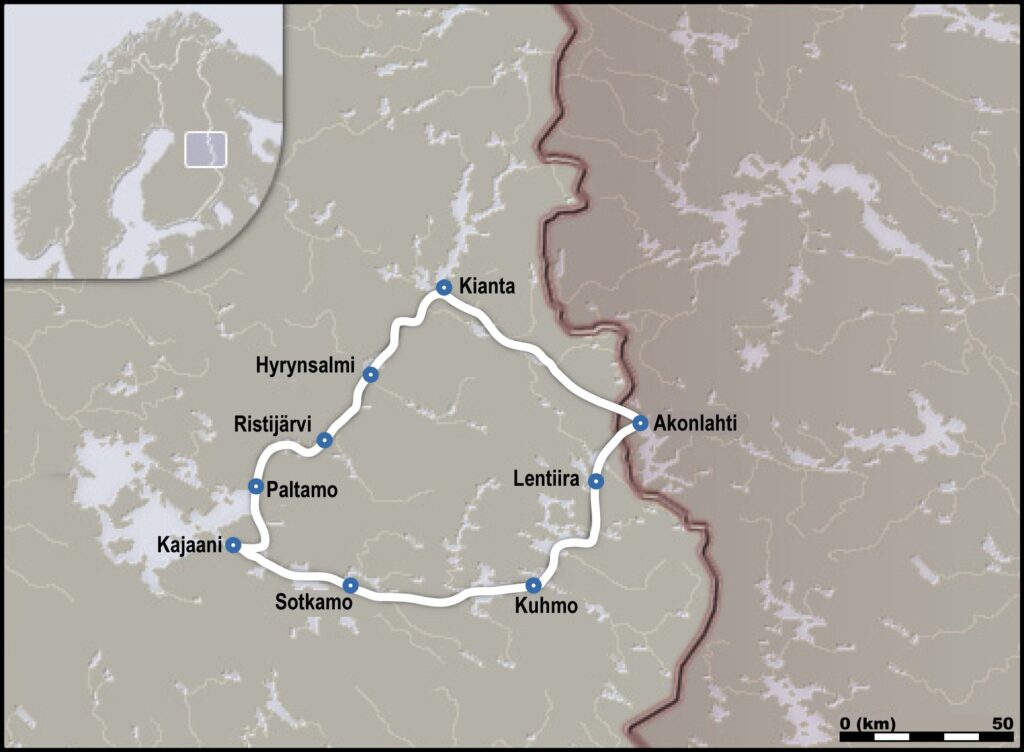
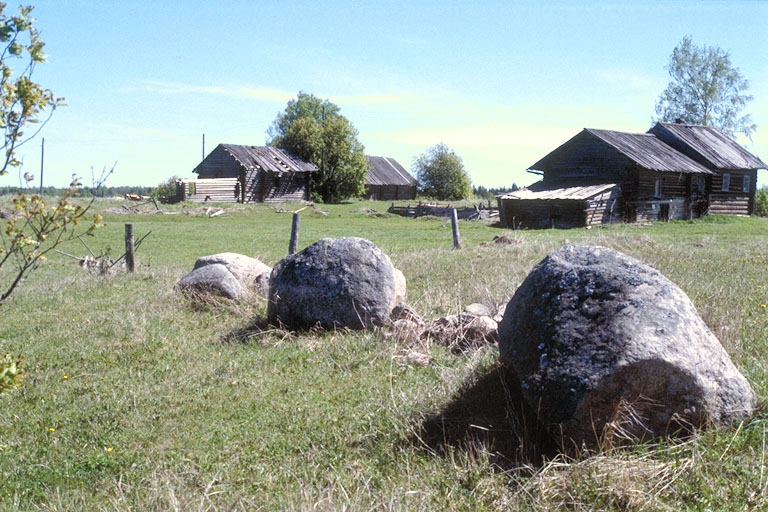
The tenth journey 1841 - 1842
Lönnrot's last two journeys were language research trips. They headed far from Kainuu. On the 10th journey, he went to M. A. Castrén and his partner in the Finnish Lapland, the Kola Peninsula and the coast of the White Sea in Karelia, from where he sailed to Arkhangelsk.
From there Castrén left for Siberia and Lönnrot to the land of the Vepsians.
One of the later results of this trip was Lönnrot's dissertation on the Veps, when he had to complete a degree in linguistics after becoming a professor of Finnish in Helsinki.
The eleventh journey 1844
His 11th trip brough him to Estonia.
He studied Estonian in Tarto and during his jounrey he met the writer of Kalevipoeg as well as other culturally significant people.
During his way back, he passed though the lands of the Votes and wrote down several poems.

